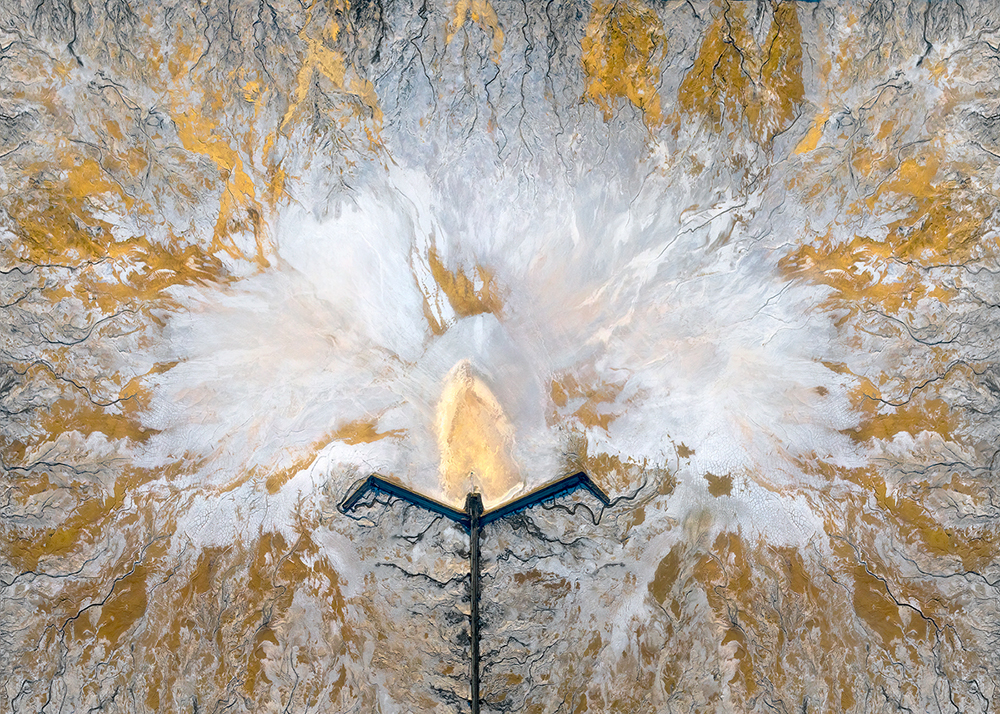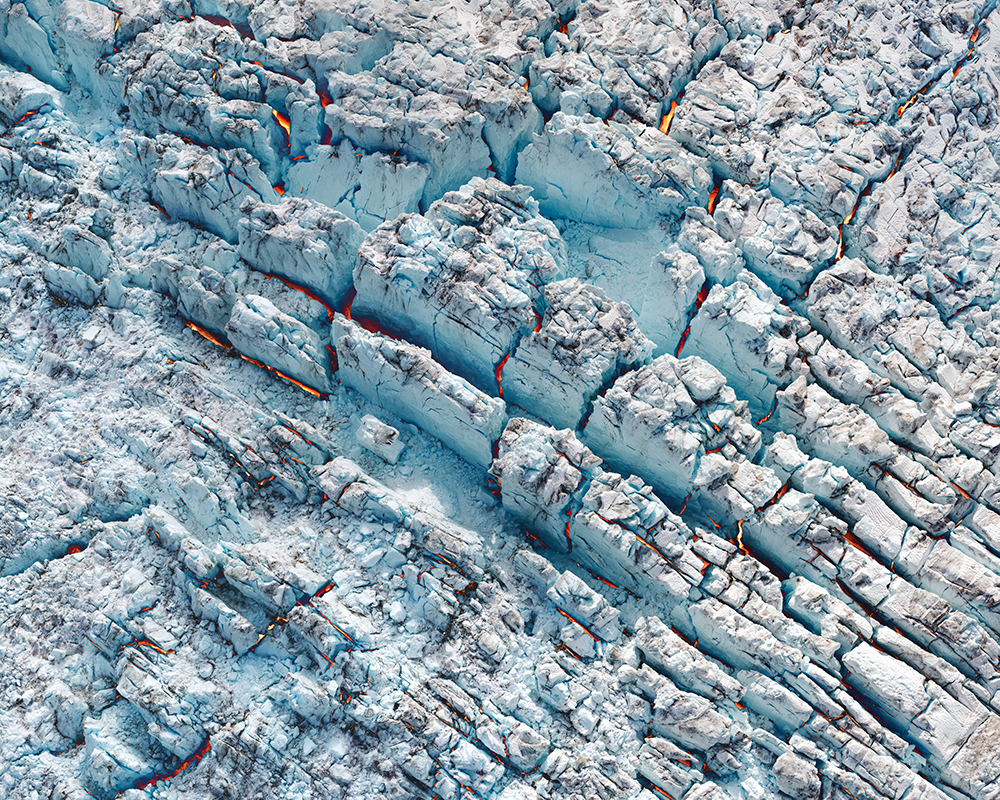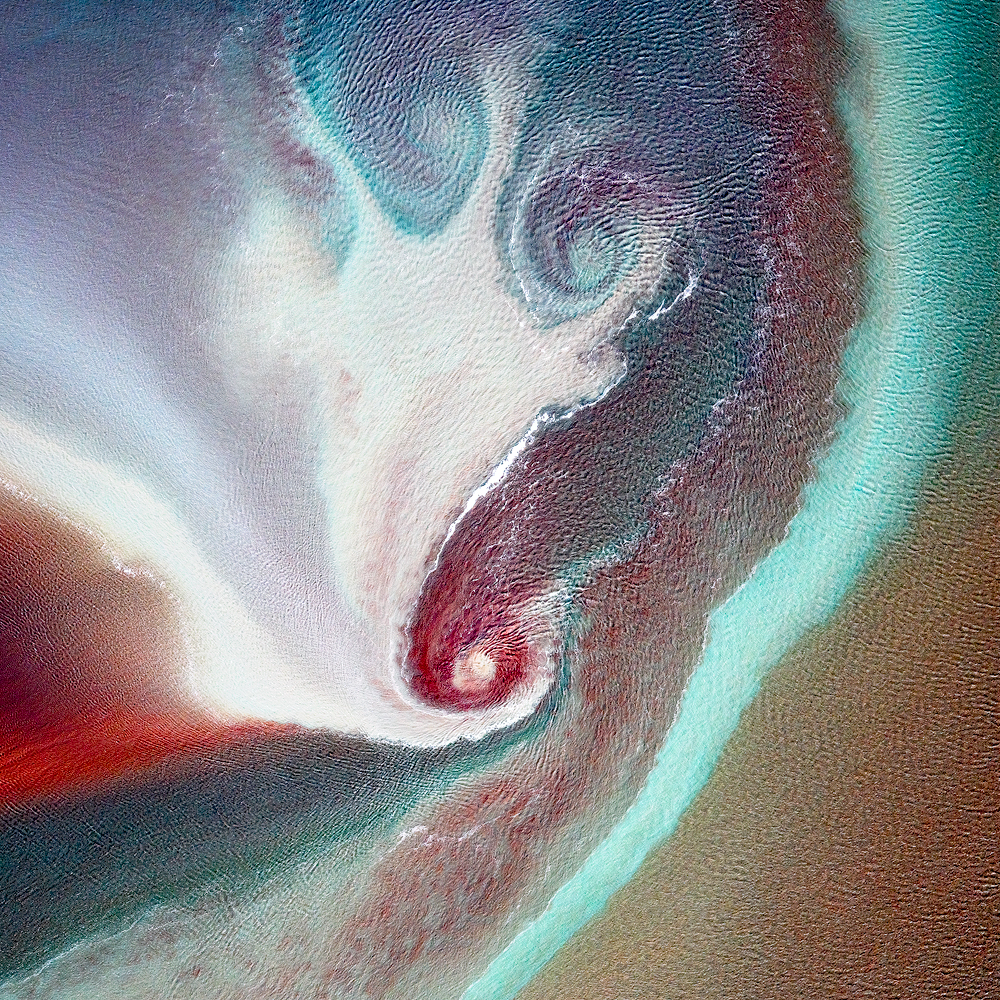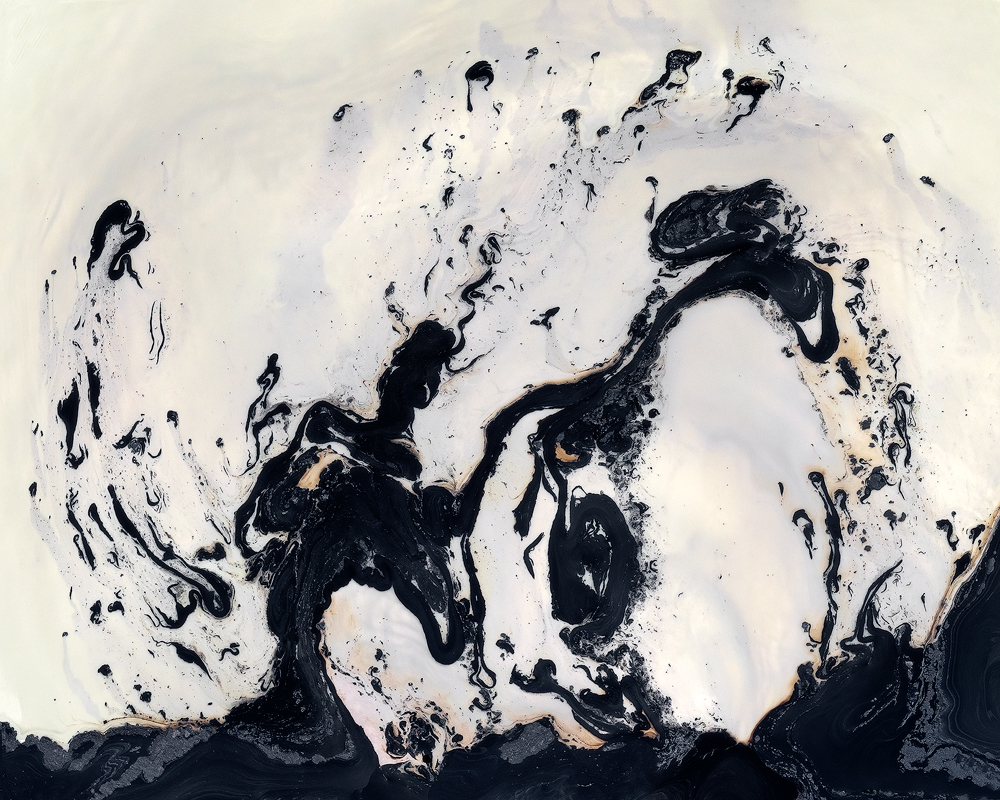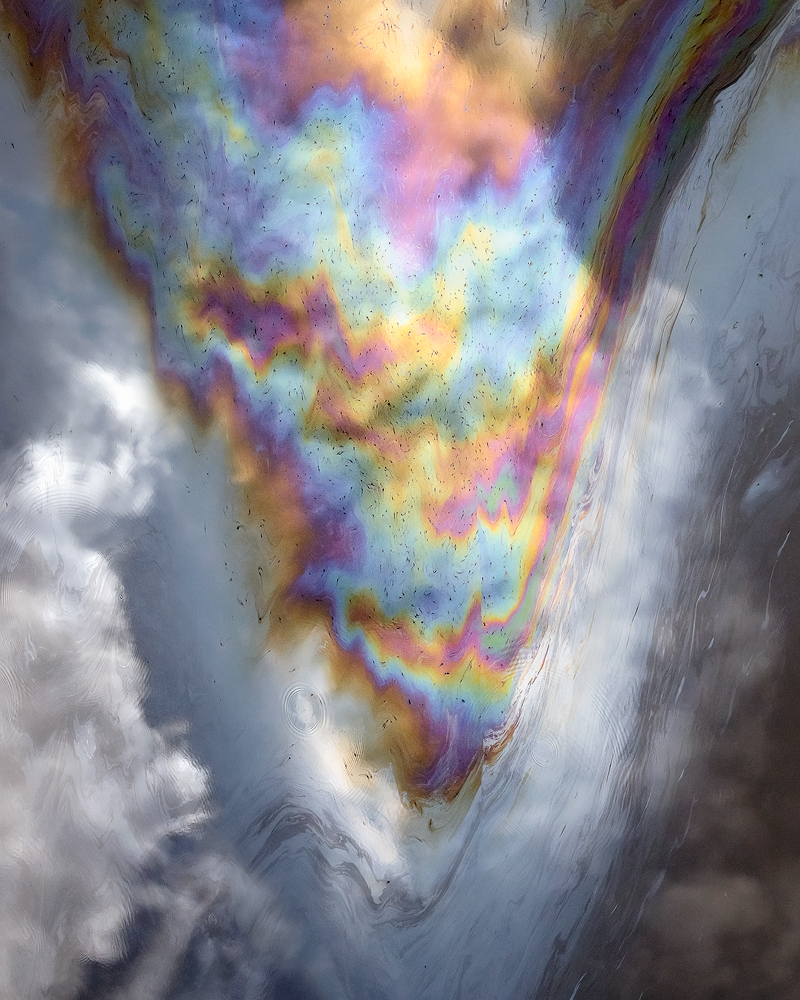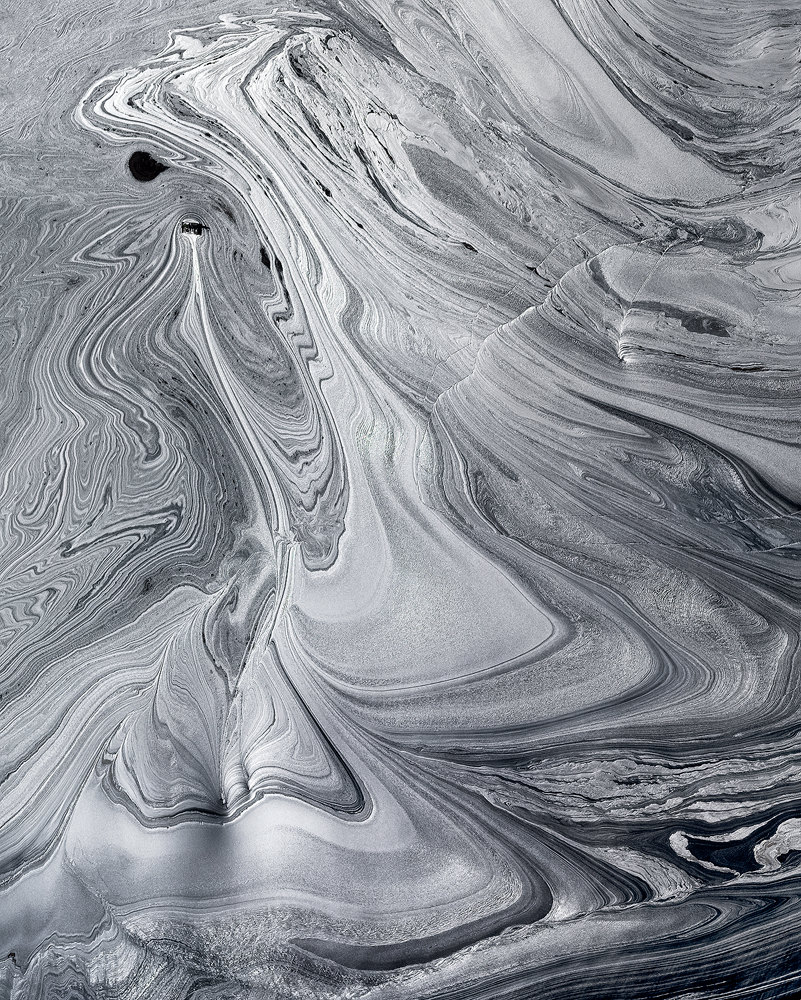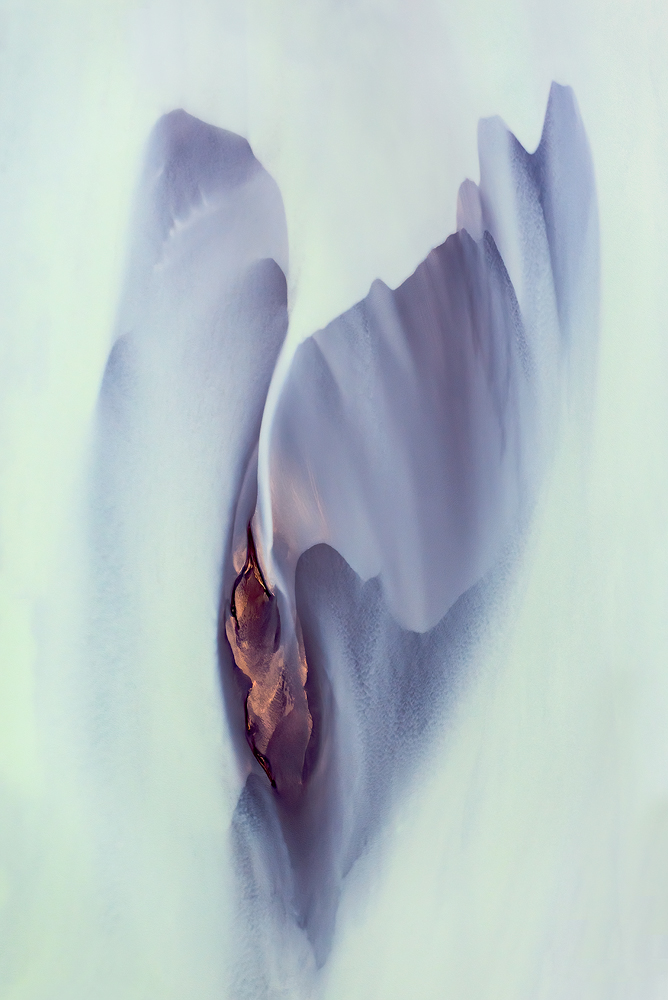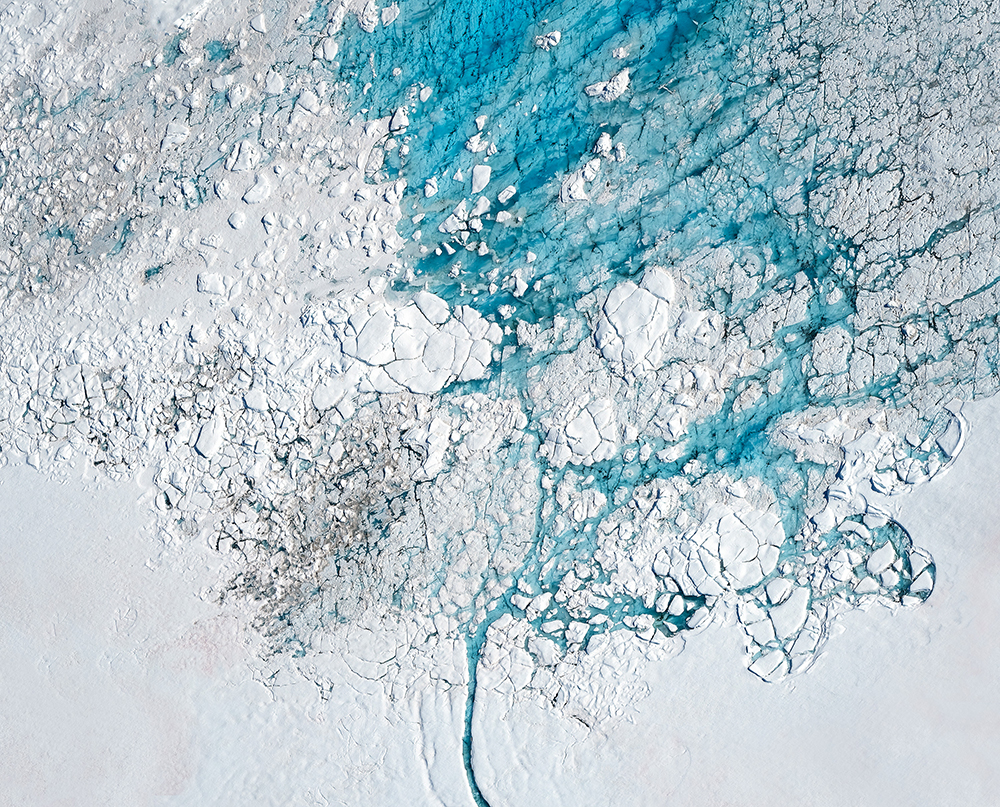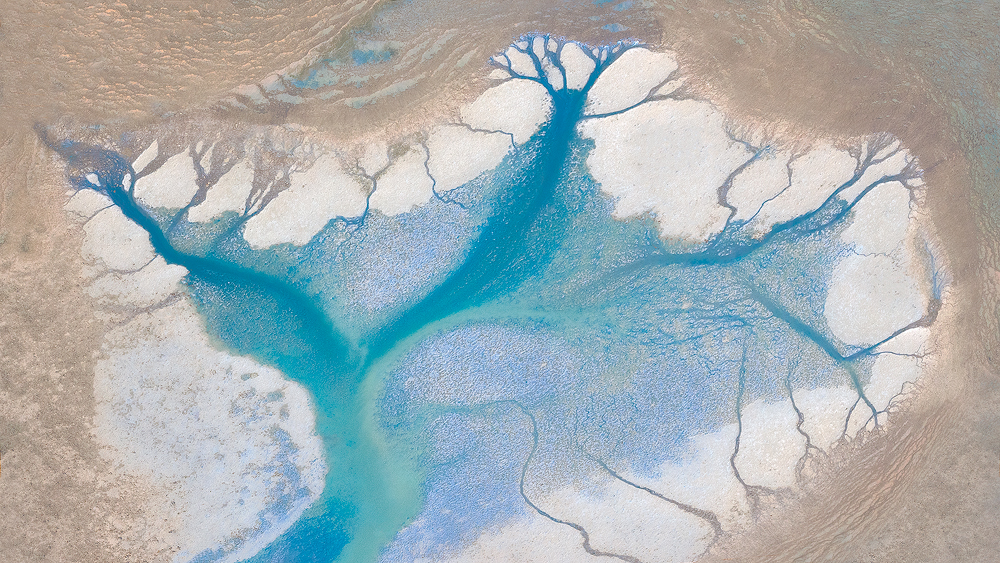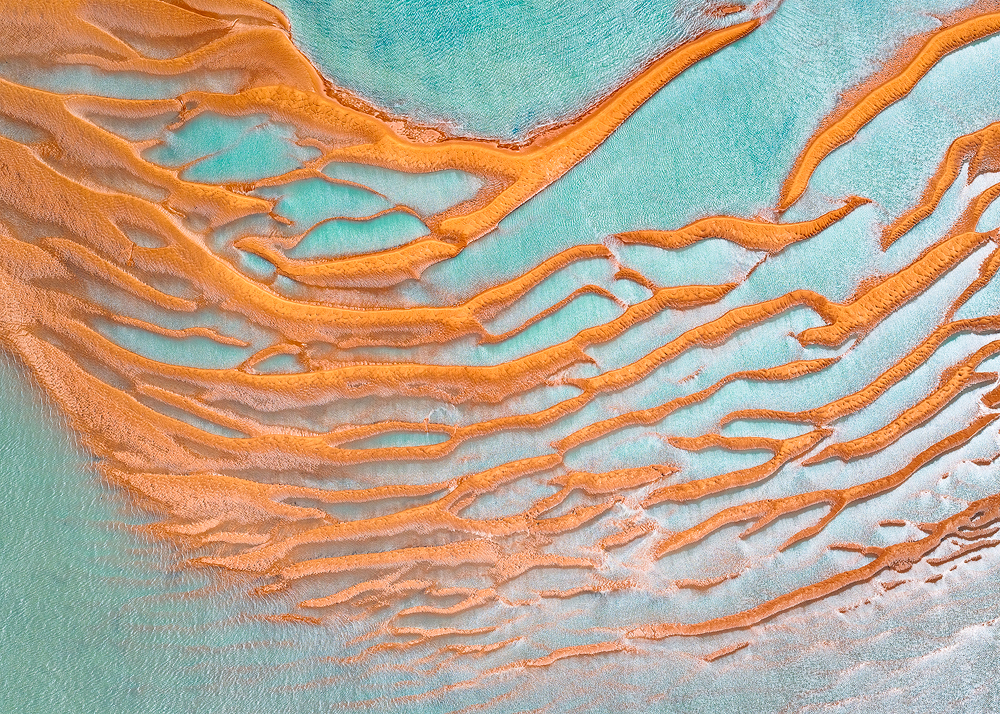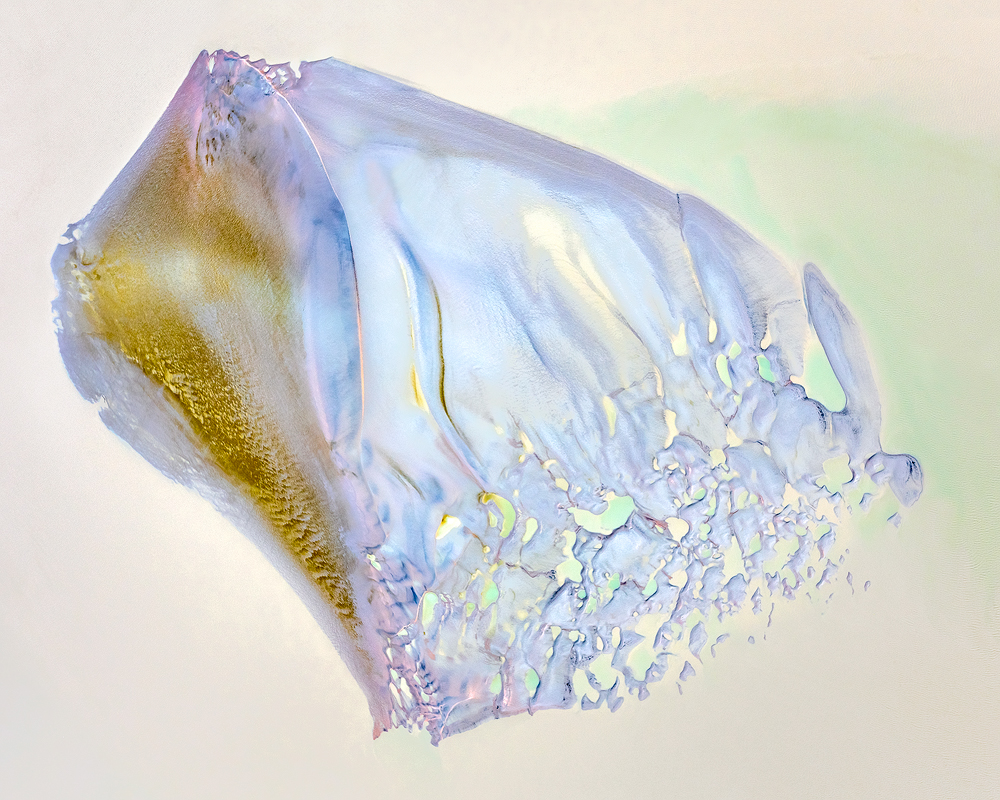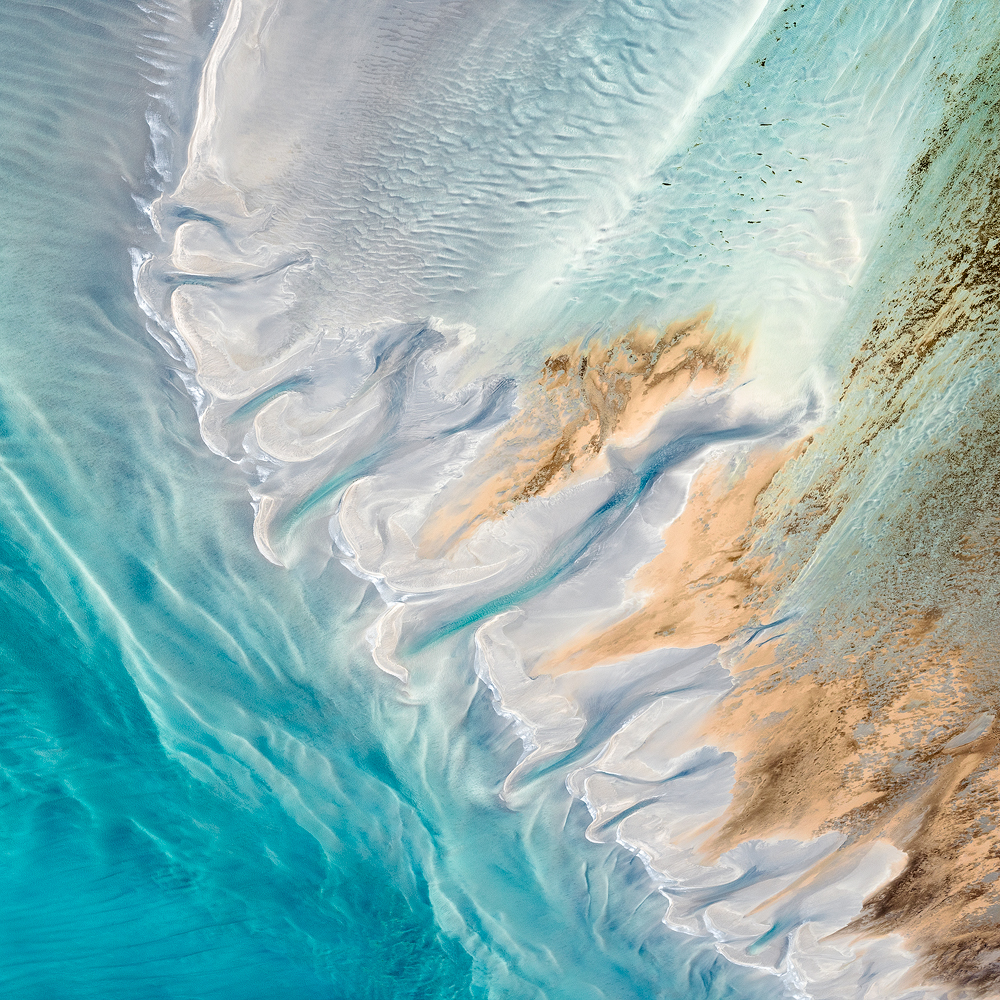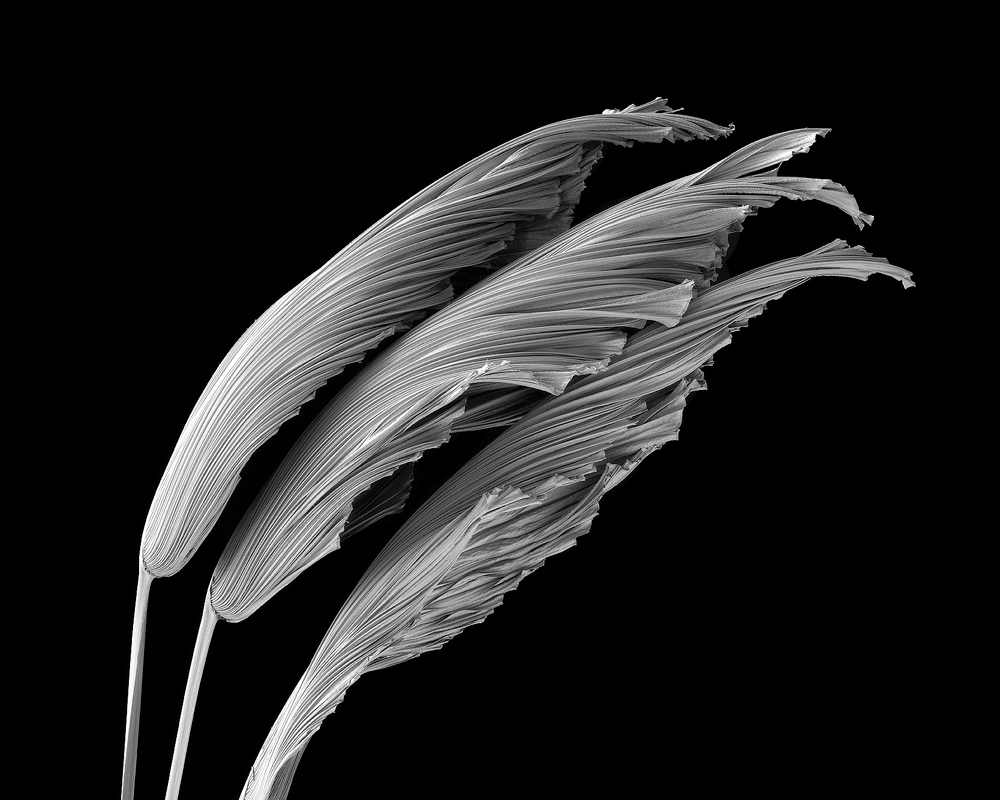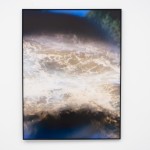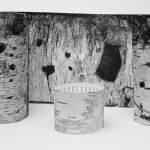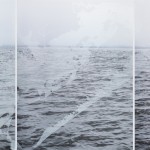Carolyn Cheng: The Feminine Sublime
“Not only did I find the view from above to be novel, but I also found photographing from above to come far more naturally, where my creativity and competency were able to flourish.”
I recently read a terrific interview with photographer Carolyn Cheng in Elements Magazine. I reached out to the editor, Olaf Sztaba for permission to re-run the article and not only call attention to Cheng’s exquisite work, but to the excellent publication it was being featured in. Thankfully he agreed!
There is something magical and compelling about looking at the earth from above. Cheng masterfully uses the earth as her canvas as she crops and edits pieces of the planet into spectacular abstracts of color, shape, and form. She shows us ice and snow that look like the embers left in the fireplace, and swirling colors that would replicate mid-century paintings. Her photographs are important reminders of the beauty of this planet we call home.
Carolyn Cheng is a contemporary Canadian photographer currently living and working in Toronto, Ontario. She has shown at Gallery 44, the Toronto Outdoor Art Fair, the Art Gallery of Hamilton, the Robert McLaughlin Gallery , the Metropolitan University’s Paul H. Cocker Gallery and Remote Gallery. Her work is also held in various private collections.
Cheng’s images have been published in On Landscape, Elements, Photo Ed Magazines and National Geographic’s Photo of the Week series. She has also received awards from Critical Mass, the Prix de la Photographie Paris (PX3), the International Photography Awards (IPA) as well as the International Landscape Photographer of the Year program.
Follow on Instagram: @carolynchengphotography
As an artist, I re-examine traditional elements of landscape photography from an abstract aerial perspective by transforming water, sand and earth, to investigate aspects of the feminine sublime in the natural world. By using the landscape as a medium rather than a subject, I endeavour to engage the viewer with painterly shapes, lyrical patterns and the vibrant colours of the landscape unimaginable from the ground.
Whereas historical representations of the Sublime depicted scenes of nature inspiring fear or eliciting domination over the landscape, my images differ by using abstraction to remove all sense of scale and dominion. While exploring nature’s ephemeral and fantastical phenomena, I portray the landscape with a kind of intimacy created by abstraction, possible from an immense distance when seeing the land from the sky. More recently, in the studio, I’ve been using the abstraction of black and white inversion and solarization to depict botanical vignettes from bud to bloom to withering. My images focus more intently on the dynamic and transmutable nature of the landscape, as I depict it in a fashion that is more approachable, cyclical and alive. My intention is to connect the viewer to the landscape through an affective response to its beauty, as ordinary terrestrial elements become elevated to the otherworldly. – Carolyn Cheng
Elements Magazine Interview
Could you please tell us about your early development as an artist? Did you have any interest in art or photography when you were young?
I was always driven to express myself artistically, although my main passions growing up came in the form of dance and Chinese calligraphy. After university, I first discovered the joy of creating artistic images on film, together with the science and alchemy of making images in the darkroom. I was hooked but given that dark room development was more labour intensive at the time, I was unable to pursue it in any depth alongside my demanding career.
Nonetheless, after this experience, I continued to pursue photography in my travels, but now with a digital camera and the digital darkroom, which opened up more possibilities, especially with the reduction in darkroom processing time. Initially, photography was more of a means to document my trips rather than to express myself artistically. However, life inspires art at times, and when I sustained an injury which prevented me from chasing my competitive cycling pursuits, I was inspired to re-engage with photography, but this time with a more intentional artistic purpose.
Early in my photography career, I was fortunate to be introduced to my mentor Jess Thalmann. Jess is an artist, curator, and educator, represented by a gallery here in Toronto. She has helped me navigate the fine art world and contextualize my work in the language and movements of art history, responding to exhibit submissions, curating collections and charting a path for future development. I have also joined a local artist-run centre, which has led to a number of group exhibits. I plan to take a Masters of Fine Arts degree in the future.
How did you start in photography? Where did your fascination with the abstract aerial perspective come from?
I was lucky to be introduced to aerial photography in my first couple of landscape photography workshops, as it set the direction for my current artistic pursuits. Not only did I find the view from above to be novel, but I also found photographing from above to come far more naturally, where my creativity and competency were able to flourish. I was drawn to both the exhilaration of the experience as well as seeing the world from a new perspective. In my daily life and work, I discern patterns from complex sets of information. From the air, I also abstract the landscape into shapes and patterns and my eye is immediately drawn to those formations which elicit an emotional connection.
Are there any photographers who influenced your photography early on?
When I first began thinking about photography, it was the images of Marsel van Oosten, Sarah Marino and Antony Spencer that really inspired me.
On my journey, I credit David Thompson for helping me accelerate my artistic development. He’s taught me about the importance of both composition and processing in helping create a holistic artistic vision. As a mentor, he is someone who always provided the type of constructive criticism and positive support that helped me develop my own style. I am incredibly grateful to have met him relatively early in my journey.
With my botanical work, I am most drawn to the seductive and sensual work of Robert Mapplethorpe for both its visual and emotional appeal. With my most recent environmental work, I was inspired by Richard Mosse’s use of surveillance technologies. His work tends to push the limits of the documentary image and makes visible what we can’t always see. He aims to tell political and environmental stories in ways that are more powerful than we’ve previously experienced. For anyone interested, here’s a video of Richard discussing What The Camera Cannot See for Art21.
Do you have a photo which has paved the way for your later success or one that is very special to you?
Ode to Georgia O’Keeffe is the image I am most well known for and my most purchased piece. I took this image on my first solo aerial trip where I had full creative control. Instead of using a 24-70mm zoom lens, I fully committed to using my 85mm prime lens, to portray the beauty of the famous Icelandic deltas in an abstract manner. This aerial gallery represented the fullest expression of my creative voice. For those reasons, I have always felt that Ode to Georgia O’Keeffe, and the body of work associated with it, marked the beginning of my journey as an artist.
I do find that, every few years, as I evolve as a photographer, there is a special image that is representative of my creative breakthroughs. The most recent of these special images is Embers I. With my project-based work highlighting altered landscapes, I was seeking a way to demonstrate the stark effects of climate change. In the process of experimentation, I expanded my use of solarization, from the black and white solarization I used in my botanical work, to colour solarization for my recent images from Alaska. Colour solarization created a tension within the images, especially when the darks in the blues became bright orange, showing the glaciers burning as figurative wooden embers, symbolic of glaciers both melting and receding over time. It evokes a sense of urgency to the image, as the juxtaposition of fire and ice reflects the uncomfortable truth that our actions are affecting these ecosystems in an unnaturally short amount of time.
How does crafting abstract aerial imagery differ from photographing more traditional landscapes? What’s the greatest challenge?
In my experience, creating abstract photography is a very personal and intuitive practice. From the air, I’m drawing on both conscious and subconscious influences in producing images. As I view patterns and images from above, I am consciously trying to craft the most compelling image out of the shapes and patterns that are familiar to me. At the same time, the speed at which the landscapes pass by is very fast, as such, some of what I photograph is based on feeling or instinct. My subconscious mind is equally active in the shooting process under these conditions. In this sense, I think the inspiration for my abstract aerial photography is the sum of my life experiences and the greatest challenge, for those that are more technical or deliberate, is to work in a more intuitive manner. I assure you this is possible, as I am very analytical on the ground, and given the luxury of time, I tend to overanalyze! But in the air, as your desired image may only be available for a few moments, I have learned to embrace my instincts and let the creative process flow.
You said that you are “using the landscape as a medium rather than a subject.” Could you please expand on this statement.
When you are abstracting shapes and patterns of a landscape from the sky, often the landscape itself is not discernable. Viewers focus on the shapes and patterns themselves and the meaning or emotions conveyed to them. It is often, only if they zoom in on the image digitally or see the image up close in person, that they come to understand that they are looking at a landscape. The ripples or waves from a body of water become visible or sedimentary deposits come into relief. Viewers have a moment of simultaneous comprehension and disbelief, which I find very rewarding.
What is one visual exercise which you could share with our readers to help them see and compose stronger abstract and intimate photographs of the landscape?
I would suggest starting with a mid or telephoto prime or zoom lens which will provide a field of view that can better “see” the shapes and patterns within a particular landscape, rather than the landscape as a whole. Once you see the abstraction that is interesting and compelling, take a photo and use it as a starting point. At times, this first photo may be intrinsically compelling, however, some images become even stronger with more iterations. One approach is to abstract the area further into more shape and texture. Then review and assess to see if that different field of view creates any additional interest. In some cases simplifying the image can make it less interesting. If this is the case, it can be helpful to expand the field of view, bringing together different individual elements to create a larger cohesive abstracted whole. This latter practice tends to work better in a busy and complex landscape. By having multiple views of the same area, you can see what has worked best to convey the mood or emotion in the landscape and iterate further from there, if needed.
Could you please tell us about your typical preparations before a photographic trip.
Prior to a trip, once I’ve decided on the location, my preparations start with scouting, then finding a local flightseeing company, building a relationship with the pilot and then photographing from the air.
Scouting from afar starts with Google Earth. I scan for areas of potential interest. This is just a starting point as Google Earth’s images are not necessarily up-to-date and they may be taken at different seasons and/or times of day than you intend to fly so the colours and shapes may vary on your arrival. Some shapes are also too small or transient to show up on Google Earth. You can define your areas of interest and set a flight path but you also need to remain open and flexible for what you will actually see when you are up in the air.
Once you’ve found a flightseeing company, then it is important to build a strong working relationship with the pilot. The airplane and the pilot are in some ways akin to your tripod in field-based landscape photography – they put you in position and enable you to take the type of photographs that you envision when up in the air. The pilot needs to understand your interests and the kinds of images that you aim to capture in order to set the flight path in an optimal way. You also need to be aligned in order to maximize the artistic outcome. Sometimes, if you are lucky, a pilot who understands your purpose and who has local experience and knowledge of the region, may even point out areas of interest that you have not noticed.
Finally, I like to do some research on the area in advance of going so that I am more informed about the sites that I am seeing. In situ, I am present and responding to the landscape but with the knowledge base of the local area as a reference point. I also have the opportunity to learn more about the location while there in person, in part through osmosis, but also through engaging with local experts who are usually more than happy to share their knowledge of place. When I return home, I will do further research and interviews to round out my knowledge.
You just did your first solo exhibition. Can you tell us about your preparations for the show?
For my solo exhibition, the first step was determining the location and body of work that I would use. I had recently returned from the oil sands in Canada, and felt that the work was compelling, so I determined I would showcase that work. I picked a gallery that would allow me to fill the space, with enough room for the work to breathe, on a reasonable budget.
Once that was determined, the work began on shaping the work within the exhibition. Thus far, my first body of work had been primarily displayed as a series of photos on my website. For a show though, the body of work needs to be tailored to maximize the impact of the work for the physical space of the gallery.
To determine the size and pieces for the show, I created a 3D mockup of the gallery to preview how the pieces would look and feel in the physical space. I played with the image sizes to get the pieces to balance with each other. I tried multiple iterations with print mockups to see what colours and themes paired best to tell the story.
Once I had selected the images, then I determined what medium I would use to print and what frames I would select. With aerial images, they look great at scale so I have often chosen to create a full wall vinyl image for the focal image of the show. I also chose frames and frame colours to accentuate the work and also for impact. With my last project, Surfacing, which revealed the means of bitumen production from oil sands, since bitumen is a naturally occurring substance, I chose to go with wood frames where you could see the natural grain of the wood. I chose both black and green frames. Black reinforced the natural colour of bitumen and green was both eye-catching and unexpected but also reinforced the discomforting colour of poison as many of the images were taken over the tailing ponds, or the refuse areas from oil sands mining.
Finally, as everything is being printed, framed and built, I’m reading and researching to determine the name of the show and finalize the themes that will inform my artist talk.
How do you pick locations for your type of photography?
For my current work, my locations are very project-specific. Since my oil sands work, I have been very focused on altered landscapes, or landscapes that show clear signs of the impact of significant, and often industrial, human activity. My most recent body of work is from the glaciers and glacial meltwater pools in Alaska and my upcoming work is from the dryland farms of Northern Spain.
Can you give us some insight into your printing process?
When I first started printing, I experimented with a number of papers and decided that a fine art matte paper was how I wanted my work to be presented. By departing from the classic shiner photographic papers, the final image better aligns with my work which is more organic, painterly and textured. Matte papers also tend to create a richness in colour, where you can better see the depth of an image, where the cool colours recede and the warm colours come forward. Finally, they also don’t have any glare on them when they are being placed in homes so long as the collector is also using anti-reflective glass.
In terms of my printing process, I prepare the images for print. I then work with a local printer where I can sit with him and print off test prints until we are satisfied with the image. In choosing to print on a matte paper, mid-tone colours render quite easily but blacks and blues are often quite tricky and require a few iterations. If I am printing a full show, then I want to ensure that paired images and images across the body of work, are rendering harmoniously and as expected.
Could you tell us about your current or upcoming exhibitions?
My next online show is with the Toronto Outdoor Art Fair this summer and my next in-person show is a group show with Gallery 44 in the fall. In both cases, I will be showing my Alaska work called Meltwater. It was developed just as the Earth has experienced the hottest 12 month period on record. The project statement is below:
“Meltwater” is a series of photographs that illustrate melting glaciers in remote regions of Alaska, revealing the potential effects of climate change, if unabated.
By introducing colour solarization into the series, the images showcase glaciers and meltwater pools not only in their natural state, but also in what one may consider a future dystopian world. Solarizing the images creates vivid, absurdist and surreal colour transformations; for example, blues turn to orange where fragmenting glaciers resemble the wooden embers of a dying fire or mountainous hard rock transforms into flowing molten lava. With further experimentation, solarization pushes the naturalistic liquid blue of meltwater pools into electric magenta, fuschia and green. These warm unnatural colors render glacial pools into the visually familiar weather language of heat maps and thermograms; the latter illustrating meltwater pools as literal and figurative heat markers within the ice.
In the face of the potential loss of these spectacular natural wonders, “Meltwater” invites reflection on the dramatic rise in glacier melt resulting in rising ocean levels, flooded coastal cities and challenging global weather disruptions.
You are a photographer, but it is not your only profession. Does it help or distract to keep your photography separate from your work?
Having a career outside of photography can both help and hinder photography. Without any income dependency, an artist such as myself is not required to consider the commercial aspect of photography and can be completely free to express myself artistically. However, with a demanding career, I cannot commit to focusing exclusively on my photography and have to find the right balance between my work and my other passions. As I have become more serious about photography, I find that I am my most creative self when I have less stress and distractions from other places and the more time I have to create and play helps to develop stronger work. In the future, I see myself creating a stronger balance of time between work and photography.
If I met Carolyn Cheng in a coffee shop or a restaurant, what is the most likely subject we would discuss, other than photography?
In addition to photography, I always enjoy a good conversation about world events, the future of civil society, arts and culture, travel and relationships!
What are you working on right now?
As I continue to explore the themes of altered landscapes and the human impact on the landscape, I am working on a body of work in the farmlands of Northern Spain. As land and resources continue to grow more scarce, the landscape here feels like a glimpse into the future, where every inch of land is in use from dryland farming, to wind power, to solar power, to mining with very little wild space. I first traveled there last year and plan to return again this year. I am curious to see how the work will develop.
What is your usual gear setup when shooting from the air? / What is your favourite focal length and lens for aerials?
When I am up in the air, I typically have two cameras. My primary setup is a Nikon D850 with a Sigma Art 85mm f1.4. Typically, in the air, 80%+ of my photographs will be taken with this lens. My secondary setup is a Nikon Z7II with the Nikon Z24-70 f2.8, which I use when I would like to capture a wider scene.
The article courtesy of ELEMENTS Magazine. The ELEMENTS is the monthly magazine dedicated to elegant landscape photography, insightful editorials and fluid, clean design. Inside you will find an exclusive and in-depth articles and imagery by the best landscape photographers in the world such as Charles Cramer, Christopher Burkett, Hans Strand, Rachael Talibart, Christian Fletcher, Charlie Waite, and Sandra Bartocha, to name a few. Use the LENSCRATCH10 code for a 10% discount off the annual subscription.
Posts on Lenscratch may not be reproduced without the permission of the Lenscratch staff and the photographer.
Recommended
-
Paccarik Orue: El MuquiDecember 9th, 2025
-
Jackie Mulder: Thought TrailsNovember 18th, 2025
-
Interview with Maja Daniels: Gertrud, Natural Phenomena, and Alternative TimelinesNovember 16th, 2025
-
Mara Magyarosi-Laytner: The Untended GardenOctober 8th, 2025
-
Conner Gordon: The OverlookOctober 4th, 2025

